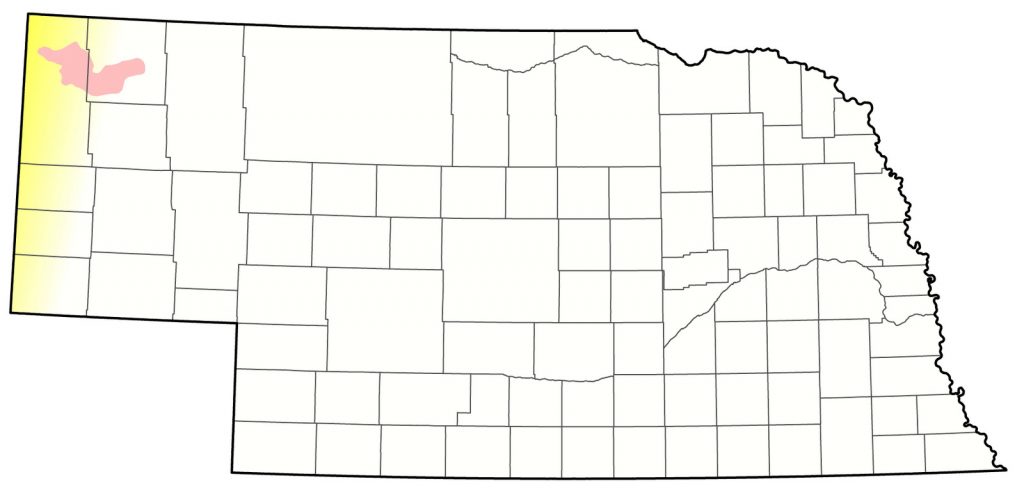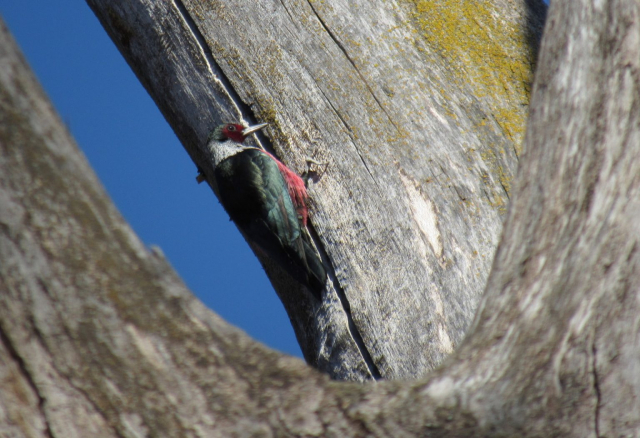Melanerpes lewis
Status: Rare casual spring migrant west and west central. Rare casual fall migrant west and central. Rare regular local breeder west. Accidental winter visitor.

Documentation: Specimen: UNSM ZM6299, 30 May 1900 Warbonnet Canyon, Sioux Co.
Taxonomy: No subspecies are recognized (AviList 2025).
Spring: Away from known breeding locations, there are few records, most in the Panhandle and west central: 3 May 2020 near Lewellen, Garden Co (Marquene Koontz photo, fide Charles Brown), 8 May 2009 Dundy Co (Brogie 2009), 12 May 2004 Bordeaux WMA, Dawes Co, 13-15 May 2022 southeastern Morrill Co, 16 May 2024 Harrison, Sioux Co, 18 May 2024 Lakeside, Sheridan Co, 25 May 2017 Harrison, Sioux Co, 27 May 1995 (2) Crawford City Park, Dawes Co, and 6 Jun 2015 Lincoln Co.
There are two records in the east central, one over 100 years ago: 11-16 May 2003 near Gibbon, Buffalo Co (Brogie 2005), and 16 May 1900 Kearney (specimen in Olson Collection, Swenk, Notes Before 1925),
Summer: Numbers have declined markedly throughout the species’ range since the 1960s (Vierling et al 2020). It is migratory in northern parts of its range, as in Wyoming, where it is a “summer resident” May-Sep, with very few records in Oct and none in Dec (Faulkner 2010). However, Tallman et al (2002) describe it as a “locally uncommon Permanent Resident” in the Black Hills of southwest South Dakota, where it retreats to lower elevations in winter in search of acorns. Tallman et al (2002) cite Peterson (1990) regarding timing of occupation of pine forest after burns by various woodpecker species; Lewis’s Woodpecker is one of the last to appear, usually after several years and generally only in very large burned areas.
Around 1900, Lewis’s Woodpecker was a “Common summer resident and breeder” on the Pine Ridge and in Scotts Bluff Co (Bruner et al 1904). Since then, and prior to the Dead Horse Canyon fire in Dawes Co in 1973, this species was as often recorded away from the Pine Ridge as not, suggesting that it was merely a migrant or vagrant in the state. Since the 1973 fire, it has summered and bred irregularly on the Pine Ridge (Rosche 1982, Mollhoff 2022). Mollhoff (2000) estimated that the total annual breeding population in the state was no more than 10-20 pairs.
Irregular breeding of this species in Nebraska is probably due to Nebraska being at the periphery of the species’ range, the irregular availability of burned pine woodland habitat, relatively open pine forest with understory, and competition with its congener, Red-headed Woodpecker. After using burned forests for breeding, birds may move to unburned forest after young fledge (Vierling et al 2020).
Since 1970, there have been only four instances of breeding or presence of potential breeding birds within a few years after a major forest fire which provided breeding habitat. These are Dead Horse Canyon after the 1973 fire, West Ash Canyon, Dawes Co after the 1985 McIntosh fire, near Fort Robinson, Sioux Co after the 1989 Fort Robinson fire, and lower Sowbelly Canyon, Sioux Co after the 2006 Sowbelly Canyon fire.
Following the 1973 Dead Horse Canyon fire, Lewis’s Woodpeckers began breeding there around 1978 (Rosche 1982); Gates (1981) reported 25 near Chadron SP, Dawes Co 30 Aug-24 Sep 1980, a tally which may have included both migrants and local summer residents. Nesting occurred in May 1985 (Mollhoff 2001) but the only reports since 1986 (Bennett 1987) are of one in the area 7 Sep 2018, three at two locations during 21 Jun-14 Jul 2020, and one there 26 May 2022.
Following the 1985 McIntosh fire, territorial adults were found in the area 15-22 May 1998 and breeding was documented in 1999, when, on 25 Jun, five nestlings were present in a pine snag; a fledgling was seen 13 Aug (Mollhoff 2000). Nesting continued in this general area through 2005 (Mollhoff 2001, 2004a, 2004b, 2005a, 2005b), but there were no further reports.
Following the 1989 Fort Robinson fire, Lewis’s Woodpecker was not found in summer until 1996, when two were located in Smiley Canyon 1 Aug 1996. There were no further reports and breeding was not confirmed. Two were found there 4 Jun 2020 and seen by many through 24 Jun.
The most recent and only known currently (2023) active breeding area is lower Sowbelly Canyon. On 16-19 Aug 2010, a pair with a juvenile was found there that may have been produced locally although it is possible the family group migrated into Nebraska from a different area (i.e., Black Hills). Lewis’s Woodpeckers, though, had been in the area since 2010, with best count seven in Sowbelly Canyon and the neighboring Pants Butte area 31 Jul 2012. Two were present 22 Aug 2020, singles 17-31 May and 12-28 Aug 2021, and 5 Jun 2023. Only one was reported in 2024, on 8 Sep, and none through 31 Jul 2025.
A potential new location is the Douthit fire of 2012 near Joder, Sioux Co, where two pairs were present 6 Jul 2020. One at the Hudson-Meng Bison site, Sioux Co 23 Jun 2021 may have been associated with this burn.
Summer reports away from these known breeding areas are almost non-existent and the only report since 1987 is one flushed from a burn area at NNF Bessey, Thomas Co 27 Aug 2024, possibly a fall wanderer.
- Breeding Phenology:
Eggs: 1-22 Jun
Nestlings: 14-30 Jun
Fledglings: 11 Aug
Fall: summer <<<>>> Sep 23, 28 (specimen UNSM ZM6361), 29 (Dawson 1921)
Later dates are of one in Carter Canyon, Scotts Bluff Co 6 Oct 2020, one in a burn at Chadron SP, Dawes Co 11 Oct 2004, a specimen in the Black Collection taken at Oshkosh, Garden Co 14 Nov 1916 (Swenk, Notes Before 1925), and one at Exit 1 on Interstate 80, Kimball Co 20 Nov 2019.
Lewis’s Woodpecker tends to be nomadic in fall due to its opportunistic feeding habitats (Vierling et al 2020) and the more numerous (though still few) fall records in Nebraska reflect this, with easterly records where ponderosa pine occurs, as in the Niobrara River Valley. These are 18-20 Sep 2008 Cherry Co, 18 Sep 2010 juvenile Lake McConaughy, Keith Co, two on 29 Sep 2016 Niobrara Valley Preserve, Keya Paha and Brown Cos, and 23 Sep 1989 Knox Co, the easternmost fall report for the state. There is a report without details from NNF Bessey, Thomas Co (Bray 1994).
Although irregular, at times this species historically could become conspicuous in late Aug and early Sep, when it may form flocks (Bent 1939, Scott 1993, Rosche 1982); Gates (1981) reported 25 near Chadron SP 30 Aug-24 Sep 1980, and 6-7 were in pines at the head of Monroe Canyon 29 Sep 1920 (Dawson 1921). There are no comparable records since these, however.
Winter: This species may linger into Dec or early Jan, but there is only one record of wintering (below). There are no Jan-Apr reports since the 1930s, and the only Nov-Dec reports since 1970 are 26 Nov-10 Dec 1998 Verdigre, Knox Co and one during CBC count week at Scottsbluff in 1971.
The only wintering record, completely unexpected in the east, was of one at Schramm Park SRA, Sarpy Co, first reported 18 Dec 2019 and still present 18 Jan 2020.
Images
Abbreviations
CBC: Christmas Bird Count
NNF: Nebraska National Forest
SP: State Park
SRA: State Recreation Area
UNSM: University of Nebraska State Museum
WMA: Wildlife Management Area (State)
Literature Cited
AviList Core Team, 2025. AviList: The Global Avian Checklist, v2025. https://doi.org/10.2173/avilist.v2025.
Bennett, E.V. 1987. 1986 Nebraska nesting survey. NBR 55: 31-35.
Bent, A.C. 1939. Life histories of North American woodpeckers. Bulletin of the United States National Museum 174. Dover Publications Reprint 1964, New York, New York, USA.
Bray, T.E. 1994. Habitat utilization by birds in a man-made forest in the Nebraska Sandhills. Master’s thesis, University of Nebraska-Omaha, Omaha, Nebraska, USA.
Brogie, M.A. 2005. 2004 (16th) Report of the NOU Records Committee. NBR 73: 78-84.
Brogie, M.A. 2009. 2009 (21st) Report of the NOU Records Committee. NBR 77: 160-168.
Bruner, L., R.H. Wolcott, and M.H. Swenk. 1904. A preliminary review of the birds of Nebraska, with synopses. Klopp and Bartlett, Omaha, Nebraska, USA.
Dawson, R.W. 1921. Fall migration in northwestern Nebraska in 1920. Wilson Bulletin 33: 35-37.
Faulkner, D.W. 2010. Birds of Wyoming. Roberts and Company, Greenwood Village, Colorado, USA.
Gates, D, 1981. Lewis’ Woodpecker in western Nebraska. NBR 49: 33-34.
Mollhoff, W.J. 2000. Review of the breeding status of Lewis’s Woodpecker in Nebraska. NBR 66: 50-55.
Mollhoff, W.J. 2001. The Nebraska Breeding Bird Atlas 1984-1989. Nebraska Ornithologists’ Union Occasional Papers No. 7. Nebraska Game and Parks Commission, Lincoln, Nebraska, USA.
Mollhoff, W.J. 2001. 1999-2000 Nebraska nesting report. NBR 69: 92-101.
Mollhoff, W.J. 2004a. The 2001 Nesting Report. NBR 72: 99-103.
Mollhoff, W.J. 2004b. The 2002 Nebraska Nesting Report. NBR 72: 153-158.
Mollhoff, W.J. 2005a. The 2003-2004 Nebraska nest report. NBR 73: 15-19.
Mollhoff, W.J. 2005b. The 2005 Nebraska nest report. NBR 73: 119-123.
Mollhoff, W.J. 2022. Nest records of Nebraska birds. Nebraska Ornithologists’ Union Occasional Paper Number 9.
Peterson, R.A. 1990. A birdwatcher’s guide to the Black Hills. PC Publishing, Vermillion, South Dakota, USA.
Rosche, R.C. 1982. Birds of northwestern Nebraska and southwestern South Dakota, an annotated checklist. Cottonwood Press, Crawford, Nebraska, USA.
Scott, O.K. 1993. A birder’s guide to Wyoming. American Birding Association, Colorado Springs, Colorado, USA.
Swenk, M.H. Notes before 1925. Bird notes from A.M. Brooking of Hastings, C.A. Black of Kearney, and B.J. Olson of Kearney, based chiefly on their collections, up to January 1, 1925. Typed manuscript in the Nebraska Ornithologists’ Union Archives, University of Nebraska State Museum, Lincoln, Nebraska, USA.
Tallman, D.A., Swanson, D.L., and J.S. Palmer. 2002. Birds of South Dakota. Midstates/Quality Quick Print, Aberdeen, South Dakota, USA.
Vierling, K.T., V.A. Saab, and B.W. Tobalske. 2020. Lewis’s Woodpecker (Melanerpes lewis), version 1.0. In Birds of the World (A. F. Poole, Editor). Cornell Lab of Ornithology, Ithaca, NY, USA. https://doi.org/10.2173/bow.lewwoo.01.
Recommended Citation
Silcock, W.R., and J.G. Jorgensen. 2025. Lewis’s Woodpecker (Melanerpes lewis). In Birds of Nebraska — Online. www.BirdsofNebraska.org
Birds of Nebraska – Online
Updated 24 Aug 2025

